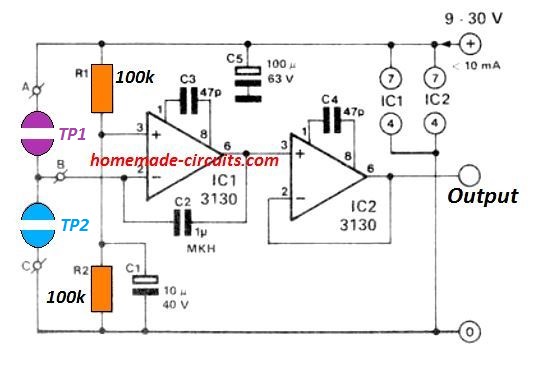In this touch operated potentiometer circuit we have two touch pads, which produce a slowly increasing voltage at the output when one touch pad is touched, and a decreasing voltage when the other touch pad is touched.
When the touch contact is removed the voltage holds at that particular increased or decreased level "permanently".
Touch pad switches typically work by incorporating a basic digital memory system. However these could be also operated to allow an analogue output voltage as in this article through a low cost circuit which is simple to construct.
Circuit Description
The circuit is centered around the IC1, an op amp having a extremely high input impedance, that is configured as an integrator.
When touch-pad TP1 is touched with a finger, capacitor C2, an MKT type low leakage capacitor charges through the resistances of the skin, which triggers the output voltage of IC1 to decrease linearly to zero.
If the second touch-pad, TP2, is touched, results in an opposite response. Now, the voltage output of IC1 increases linearly to a level that's equal to the supply voltage.

The best feature of this touch operated potentiometer circuit is that as soon as the finger contact is removed from the pad, the voltage magnitude then appearing at the output of IC1 is retained by the stored charge on C2.
On account of inevitable leakage currents in the capacitor, the output voltage will, eventually, start drifting by approximately 2 % each hour towards zero or towards the supply voltage, depending on which specific key pad had been touched last.
To ensure that the leakage current is as minimum as possible, it is important to keep the circuit away from humidity or dampness.
This is a crucial aspect that must be taken into account while implementing this design.
Applications
The applications possibility for this of this solid state touch pad potentiometer circuit can be extensive: it could be used just about anywhere that requires a potentiometer for generating a touch operated variable voltage.
If you want to employ standard push button switches as an alternative to touch pad, the following figure explains how this could be implemented by substituting the touch pad points.

Resistors R3 and R4 imitate the skin resistance; switches S1 and S2 supply the input potential to the IC1.
If you press the two switches together the output will stay unaffected and won't produce any variation in its existing value.
Capacitors C3 and C4 eliminate all possibility of the operational amplifier to go into an oscillation mode.
me interesan sus circuitos pero tengo un problema con ssus paginas al llegar ala14 ya no puedo seguir abansando gracias
¿A qué página 14 te refieres? por favor aclare Muchas gracias por su colaboración.